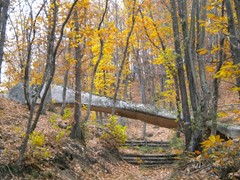Municipality of Polinago.
Between history and nature: The Castle of Brandola, and the ancient hamlets of Gombola and Talbignano
Continuing along our historical itinerary in the footsteps of the Montecuccoli family, we enter the Municipality of Polinago, lying in the Rossenna stream valley, which was home to early settlements; Etruscan, Celtic and then Roman. But it was during the Middle Ages that the territory assumed a certain importance thanks to the feudal families Da Gomola and Montecuccoli who governed central Frignano.
One interesting excursion is to visit the neighbouring hamlets of Talbignano, Brandola and Gombola, where you can relive history by strolling among ancient castles and wooded hills, that evoke historical events and ancient legends. The first news we have of Brandula is from 1001 with a reference to the Beata Vergine church. During the same century the castle was built, which became an important stronghold in the defence system of the Da Gomola family of Lombard origin, who swore allegiance to the Commune of Modena.
Later on, in the 1200s, Brandola became one of the centres of Ghibelline resistance against the Guelphs. In 1265, the Grasolfi, Ghibellines from Modena, barricaded themselves inside the castle and rode out a three-day-long siege by Guelph troops. In 1268, during a further violent battle, the Ghibellines were forced to surrender to the Guelphs, who had dug two tunnels beneath the tower to make it collapse, and in the end destroyed the fortalice. Immediately rebuilt, the Castle of Brandola played a fundamental role in the rebellion against Marquis Azzo d'Este, sheltering some rebels who ended up founding the Republic of Modena in 1306. This was followed by years of intense conflict, first against the Commune of Modena, and later against Passerino Bonaccolsi, the new lord of the city.
During the 13oos, Brandola passed to the Montecuccoli who kept possession until 1408, when the fiefdom was assigned to the Pio from Carpi.
It is now possible to visit the interior of the castle. Access is via a lane that rises through the woods amongst centuries-old chestnut trees, and then passing through the arched gateway which leads to the village surrounded by ancient walls. The current layout of the castle traces the original one, evident in the perfection of the squaring off of the foundation ashlars, a widespread technique in the Middle Ages. Inside the walls we find the Podesteria building, the former residence of the Podestà, the seventeenth-century belltower, conceivably made out of one of the castle’s towers and the church, now deconsecrated, very likely built where the keep once stood, and the main part of the castle that was destroyed in the 1268 battles.
One particularity of Brandola’s territory is an ancient sulphur spring discovered in 1448 and easily reached from the castle via an enchanting route surrounded by wild nature.For centuries, the local population believed this spring to be curative and miraculous so much so that they marketed it in bottles. Both the Este and the Montecuccoli made heavy use of it. An ancient treatise from 1763 entitled “Of the Water of Brandola – Dissertation by Domenico Vandelli dedicated to his serene highness Francesco III Duke of Modena, Reggio, and Mirandola” tells of the virtues of the “mineral waters of Brandola”, illustrating tests, chemical analyses and ways of taking them recommended by leading experts in the contemporary medical field.
Just a few hundred metres from Brandola, near Pontercole, we come across the so-called Ponte d'Ercole – Hercules’ Bridge, a monolithic formation 33 metres long where natural erosion has formed a striking grand arch which looms over the narrow Lavacchiello stream. This particular and evocative geological formation is also known as the Ponte del Diavolo – The Devil’s Bridge. An ancient legend passed down in local dialect recounts that the Devil, distracted by a group of witches who used to dance in the wood during the night, left the bridge behind. The Devil was going to exchange the bridge for the soul of a local farmer who needed it to reach his allotments.
Other places of interest just a few kilometres from Polinago are the hamlets of Talbignano, with its seventeenth-century Cesis Palace, and Gombola, built on top of the ruins of a formidable fortalice destroyed by a landslide in 1569, and home to an ancient mill with grindstones still in perfect working order.
